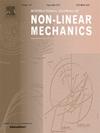Dynamics analysis of a bistable 2-DOF coupled oscillator with nonlinear damping
IF 2.8
3区 工程技术
Q2 MECHANICS
International Journal of Non-Linear Mechanics
Pub Date : 2025-01-19
DOI:10.1016/j.ijnonlinmec.2025.105021
引用次数: 0
Abstract
This paper investigates the dynamics of a novel bistable 2-DOF coupled oscillator with nonlinear damping. The system is based on a conventional bistable nonlinear energy sink (NES), with nonlinear damping introduced to enhance the vibration absorption efficiency and reduce the threshold for a strongly modulated response (SMR). Initially, the slow invariant manifold (SIM) of the system is derived using complexification-averaging and multiple scales methods. The characteristics of saddle-node (SN) bifurcation and Hopf bifurcation at the periodic fixed point are then analyzed, identifying the ranges of stiffness, damping, and other parameters that influence the SMR. Subsequently, the SIM is examined in detail across different timescales, and the amplitude thresholds of external excitation that trigger SMR are derived. Finally, the system's maximum amplitude is optimized to reduce it while ensuring the generation of SMR. A numerical analysis of the energy spectrum near the resonance frequency is also conducted to compare the vibration suppression efficiency between the conventional NES and the bistable NES with nonlinear damping. The results demonstrate that the bistable NES with nonlinear damping effectively lowers the external excitation threshold for SMR, offering a wider threshold range and higher vibration suppression efficiency. Key parameters such as the mass ratio, linear and nonlinear stiffness, and nonlinear damping significantly influence the occurrence of SMR.
求助全文
约1分钟内获得全文
求助全文
来源期刊
CiteScore
5.50
自引率
9.40%
发文量
192
审稿时长
67 days
期刊介绍:
The International Journal of Non-Linear Mechanics provides a specific medium for dissemination of high-quality research results in the various areas of theoretical, applied, and experimental mechanics of solids, fluids, structures, and systems where the phenomena are inherently non-linear.
The journal brings together original results in non-linear problems in elasticity, plasticity, dynamics, vibrations, wave-propagation, rheology, fluid-structure interaction systems, stability, biomechanics, micro- and nano-structures, materials, metamaterials, and in other diverse areas.
Papers may be analytical, computational or experimental in nature. Treatments of non-linear differential equations wherein solutions and properties of solutions are emphasized but physical aspects are not adequately relevant, will not be considered for possible publication. Both deterministic and stochastic approaches are fostered. Contributions pertaining to both established and emerging fields are encouraged.

 求助内容:
求助内容: 应助结果提醒方式:
应助结果提醒方式:


